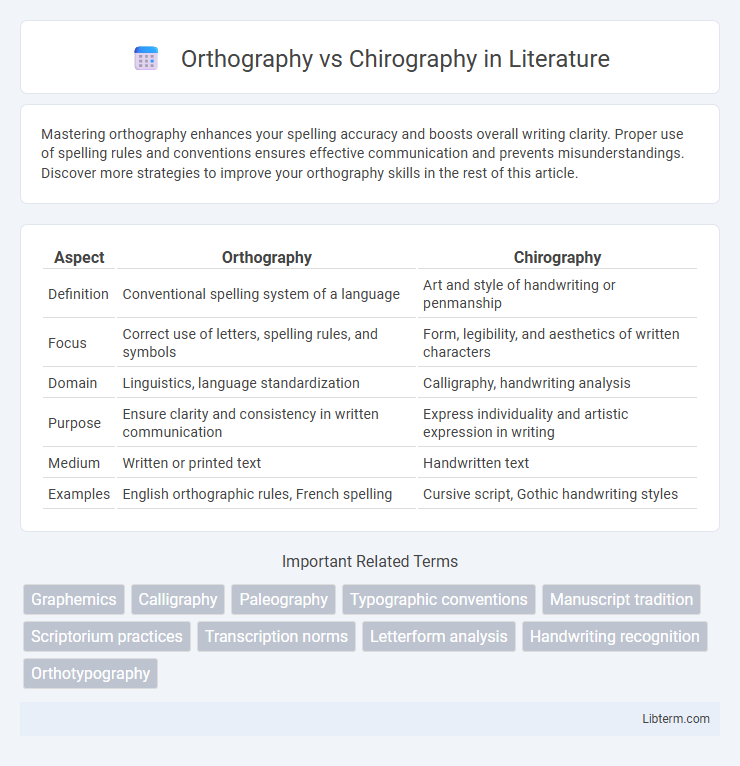Mastering orthography enhances your spelling accuracy and boosts overall writing clarity. Proper use of spelling rules and conventions ensures effective communication and prevents misunderstandings. Discover more strategies to improve your orthography skills in the rest of this article.
Table of Comparison
| Aspect | Orthography | Chirography |
|---|---|---|
| Definition | Conventional spelling system of a language | Art and style of handwriting or penmanship |
| Focus | Correct use of letters, spelling rules, and symbols | Form, legibility, and aesthetics of written characters |
| Domain | Linguistics, language standardization | Calligraphy, handwriting analysis |
| Purpose | Ensure clarity and consistency in written communication | Express individuality and artistic expression in writing |
| Medium | Written or printed text | Handwritten text |
| Examples | English orthographic rules, French spelling | Cursive script, Gothic handwriting styles |
Understanding Orthography: Definition and Scope
Orthography refers to the set of conventions for writing a language, including spelling, punctuation, and capitalization, forming the standardized system that ensures clear written communication. It encompasses phonemic representation, morphological patterns, and syntactic rules that guide correct word formation and sentence structure in written texts. Understanding orthography is essential for literacy development, language teaching, and computational linguistics applications such as natural language processing and text recognition.
What is Chirography? Exploring Its Meaning
Chirography refers to the art or study of handwriting and penmanship, emphasizing the physical form and style of written characters. Unlike orthography, which concerns the conventional spelling system of a language, chirography focuses on the individual's manual writing technique and expression. This field explores the development, aesthetic qualities, and legibility of handwritten script across various cultures and historical periods.
Historical Development of Orthography
The historical development of orthography reflects the gradual standardization of written language systems to accurately represent phonetic and morphological features, originating from ancient scripts like cuneiform and hieroglyphs. Orthographic conventions evolved through the influence of printing technology and linguistic scholarship, leading to codified spelling rules that support literacy and communication efficiency. This contrasts with chirography, which focuses on the art and technique of handwriting, emphasizing style and manual skill rather than standardized written representation.
The Evolution of Chirography Through Time
Chirography, the art and practice of handwriting, has evolved significantly from ancient inscriptions to modern calligraphy, reflecting changes in cultural, technological, and educational contexts. Unlike orthography, which concerns the standardization of spelling and written language conventions, chirography emphasizes the stylistic and manual skill aspects of writing. Advances in tools such as quills, fountain pens, and digital styluses have continuously shaped the techniques and aesthetics of chirography throughout history.
Orthography vs Chirography: Core Differences
Orthography refers to the conventional spelling system of a language, encompassing rules for letters, symbols, and punctuation that enable standardized written communication. Chirography, on the other hand, focuses on the art and technique of handwriting, including the style, form, and legibility of script. The core difference lies in orthography emphasizing correct and consistent representation of language in written form, whereas chirography emphasizes individual penmanship and the physical execution of writing.
Significance of Orthography in Language Standardization
Orthography plays a crucial role in language standardization by providing consistent rules for spelling, punctuation, and capitalization, which ensures uniform written communication across different regions and dialects. Unlike chirography, which concerns the physical act and style of handwriting, orthography establishes the normative framework that supports literacy, education, and digital text processing. Standardized orthography facilitates language preservation, reduces ambiguity, and enhances effective communication in both formal and informal contexts.
The Art and Science of Handwriting (Chirography)
Chirography, the art and science of handwriting, emphasizes the development of penmanship styles and techniques that enhance legibility, expression, and individual character. It studies the physical motion of writing, stroke patterns, and pressure control to produce aesthetically pleasing and readable scripts. Unlike orthography, which focuses on standardized spelling conventions, chirography centers on the motor skills and artistic aspects of handwriting execution.
Impact of Technology on Orthography and Chirography
Technology has revolutionized orthography by enabling digital spell-checkers and predictive text algorithms that standardize and streamline written language, enhancing accuracy and consistency. In chirography, digital tools such as tablets and styluses have transformed handwriting into hybrid forms combining traditional penmanship with electronic input, influencing motor skills and writing habits. The rise of voice-to-text and keyboard input further shifts the balance, reducing reliance on manual handwriting while reshaping orthographic norms through instant corrections and formatting options.
Educational Approaches: Teaching Orthography and Chirography
Educational approaches to teaching orthography emphasize understanding spelling conventions, phoneme-grapheme relationships, and morphological patterns to enhance reading and writing proficiency. Teaching chirography focuses on developing fine motor skills, letter formation, and handwriting fluency through guided practice, multisensory techniques, and repetitive exercises. Integrating both orthographic knowledge and chirographic skills supports comprehensive literacy development in students.
The Future of Writing: Orthography and Chirography in the Digital Age
Orthography, the set of conventions for writing a language, and chirography, the art of handwriting, both adapt uniquely to the digital age. Digital tools enhance orthographic precision through spell-checkers and predictive text, while handwriting persists as a cognitive and creative skill supported by stylus technology and digital note-taking apps. The future of writing integrates these elements, balancing standardized digital orthography with personalized chirography to enrich communication and learning experiences.
Orthography Infographic

 libterm.com
libterm.com